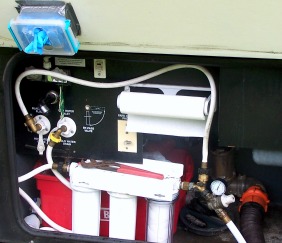There are lots of contaminants that are found in water, and they can be in 2 groups. There are those that affect only our senses of sight, smell, and taste. The other group are those that affect your health. We should address both groups of contaminants when choosing a filtration system for their RV. RV Water Filters are installed on most late model motor homes and fifth wheel trailers usually plumbed in near the water/sewer service bay. The filter element of choice in most of these is a sediment filter. Water with noticeable haze or murkiness is carrying particulate matter that is referred to as sediment. Large particles settle out of water pretty fast, so what water is carrying are very small particles. Besides the noticeable effect on water clarity, sediment can also create problems by plugging up other filters you may be using, causing them to fail prematurely. This is a good place to mention that the folks we consider experts in RV Water Filters are the people at the RV Water Filter Store. Check them out at:
http://www.rvwaterfilterstore.com
Sediment Filters
The first group of contaminants can usually be handled by sediment or “sed filters” that are measured in “microns” or one thousandth of a millimeter. A twenty micron filter will remove particles twenty microns or larger in diameter, while a five micron filter will remove sediment five microns or bigger. Sediment filters strain out the sediment and hold it. At some point, the filter is plugged and must either be cleaned (if possible) or replaced.
A sediment filter should always be the first filter in an RV water filter system. It will protect your other downstream equipment from premature failure by removing the junk that could cause a problem.
Carbon Filters
The things that affect taste and odor of water will go right through a sediment filter, so you must use something else to remove them. Enter the carbon filter. The carbon can grab onto the bad stuff in water, leaving it clean-tasting and odor-free. It can only pull out a fixed amount of contaminants, so it will not last forever. You can’t clean a carbon filter, so you must replace it when full or when water pressure and flow drop to an unacceptable level. Usually, carbon filters will last twice as long as sediment filters, but they’re also more expensive. The second group of contaminants that affect our health can sometimes be removed by high quality Carbon block filters.
Our RV Water Filter System
In my own water filter system, I use a ten micron sediment filter followed by a one micron sediment filter and follow that up with a carbon filter. The filter canisters are standard household units bought from a hardware store and plumbed together with brass fittings. This filter follows a water pressure regulator to maintain no more than fifty pounds per square inch of water pressure. Some parks have much higher pressure that can damage RV plumbing if not regulated. The regulated and filtered water is connected to the coach water inlet port. I have placed a “Y” valve just prior to the entrance to the filter so unfiltered water goes to the black tank flush inlet. Someplace in that water line to the black tank flush should be a backflow preventer device, also available at a hardware store. That will prevent the possibility of black water coming back down the line and contaminating your fresh water and filter system.
Rigs with automatic icemakers installed often have a filter in-line to the ice-maker. There may also be a separate spigot on the sink to dispense filtered water. That filter, available at Camping World, must be replaced periodically. We change ours every three months.
The whole house filter(s) must also be changed as they get filled with sediment and other contaminants. Check the first sediment filter every several weeks and look for a brown color throughout the filter media. That is the time to change it out. If it is very bad, check the next filter in line also. Carbon filters only last three months in our system.

Reverse Osmosis
If you find yourself in an area with high sodium (salt) content in the water, none of the above RV water filters will remove the salt from the water. Enter the reverse osmosis (RO) water filter system. It uses a semi-permeable plastic membrane to filter out most of the contaminants in water, including almost all biologic pathogens, minerals and salts, and some other chemical contaminants. The output side of the membrane produces pure water. The waste, dissolved solids, and contaminants which are called brine, are flushed down a drain. The costs for an RO system are much higher than regular filtration, but may be the only answer unless you buy bottled water. The RO filter removes most of the contaminants in water, including virtually all biopathogens, minerals and salts, and some other chemical contaminants.
Water Softeners
We carried a water softener for the first four years on the road. It was a black plastic thing that looked like a miniature fire hydrant. It came with hardness test strips, so I know it worked to reduce the calcium content in hard water. This calcium build-up can be a real problem for RV water heaters. The calcium crystals form and flow through the fresh water system and clog the aerators in sink faucets. They are easy to clean, but it’s inconvenient to have to do this every other day or so. The same goes for RV washing machines. Unfortunately, our softener was heavy (sixty five pounds) and only treated three hundred gallons before needing to be recharged with rock salt pellets. That container was another forty pounds or so and took up a lot of space. Consequently, we sold it. Newer units use table salt and treat up to two thousand gallons. We’re looking into these.
